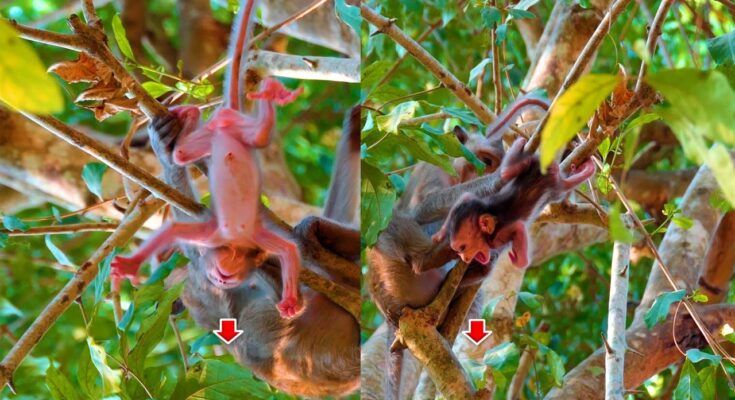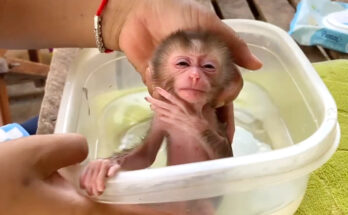In a distressing turn of events, Baby Bean, a young and curious monkey from the Real Angkor Monkey troupe, experienced a terrifying fall from a 35-meter-tall tree. This incident has sparked an emotional discussion about whether this could have been prevented and if the mother holds any responsibility.
A Shocking Incident in the Jungle
Baby Bean, known for being adventurous, had been climbing and exploring the treetops with youthful exuberance. However, the situation took a tragic turn when the little monkey lost its footing and plummeted to the ground. The fall, witnessed by other members of the troop, was both alarming and heart-wrenching.
A Mother’s Role Under Scrutiny
As the community of wildlife enthusiasts watches the footage, many have raised questions about the mother’s involvement. Could she have guided Baby Bean better? Was she neglectful, or is this just part of the natural challenges that young monkeys face while growing up in the wild?
It’s essential to remember that wild animals often face risks that are integral to their learning and survival. While this moment might seem harsh, it could also be a lesson in resilience for Baby Bean and a reminder of the unpredictable dangers of the jungle.
Baby Bean’s Current Condition
After the fall, Baby Bean was observed for signs of injury. While shaken and visibly in distress, the young monkey’s condition remains under close watch. The mother, despite initial criticism, has been seen staying by her baby’s side, providing comfort and care.
Lessons from Nature
This incident underscores the raw and often unforgiving realities of wildlife. It’s a reminder of how fragile life can be, even in the hands of nature. For those who love and follow the Real Angkor Monkey troupe, moments like these are both heart-wrenching and educational, shedding light on the challenges these animals face daily.
Stay tuned for updates on Baby Bean’s recovery and other stories from the Real Angkor Monkey troupe.
Adorable Moments: Cute Baby Monkey Activities with Mom | Real Angkor Monkey
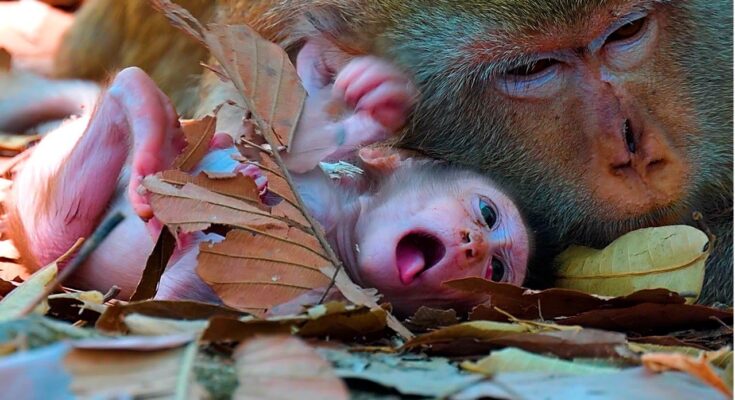
Life in the wild is a heartwarming mix of adventure and learning for baby monkeys, especially when they’re under the watchful eye of their loving mothers. In this delightful story, we explore the playful and endearing activities of a baby monkey living with its mom in the enchanting Real Angkor forest.
From climbing trees to exploring their surroundings, this little one is full of energy and curiosity. Under mom’s guidance, the baby monkey learns essential survival skills while also enjoying moments of pure play. Whether it’s chasing after falling leaves, mimicking its mom’s actions, or simply cuddling close during rest times, every activity is a mix of learning and bonding.
What makes this duo even more special is the nurturing relationship they share. The mom’s patience and care ensure her baby grows stronger and more confident each day, while the baby’s playfulness adds joy to their daily lives.
These captivating moments in the Real Angkor forest offer a glimpse into the beautiful bond between a mother and her child, reminding us of the importance of love, care, and connection in the animal kingdom.
Macaque Mother Gives Birth to Her Baby Naturally During the Daytime
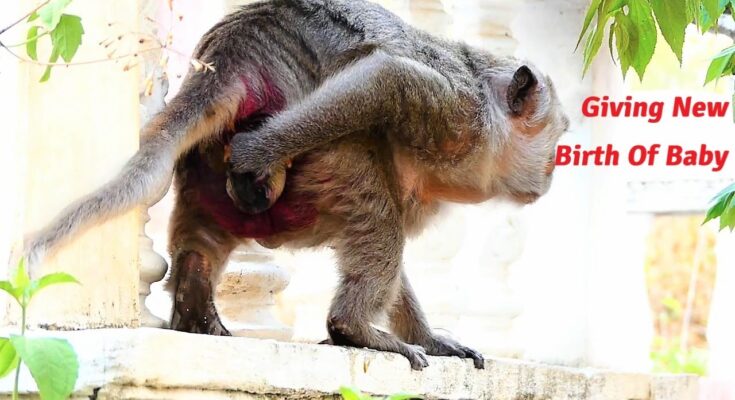
The beauty of nature unfolds in countless ways, and witnessing a macaque mother giving birth is truly a breathtaking experience. In this instance, a macaque mother gave birth to her baby naturally during the daytime, showcasing the remarkable process of life in its purest form.
A Glimpse into the Miracle of Birth
Macaques are highly social and intelligent primates, and their maternal instincts are profound. The birthing process, while challenging, is a testament to the strength and resilience of macaque mothers. Giving birth during the day provides the advantage of better visibility, allowing the mother to stay aware of her surroundings and potential dangers.
The Birthing Process
- Labor Begins: The mother macaque shows signs of labor, including restlessness, changes in posture, and occasional vocalizations.
- Delivery: The baby macaque emerges after several contractions. Macaque mothers typically give birth unassisted, relying on instinct to guide them through the process.
- Cleaning the Baby: Immediately after birth, the mother cleans her baby by licking to remove membranes and stimulate breathing.
- Nurturing and Bonding: The baby clings to the mother’s fur, beginning the vital process of bonding and nursing.
Daytime Advantage for the Mother
Giving birth during daylight hours offers several benefits for macaques:
- Improved Safety: Daylight provides the mother with a clearer view of her environment, helping her stay alert to predators.
- Access to Resources: The daytime allows easier access to food and water after the birth, ensuring the mother stays nourished.
- Support from the Troop: In social groups, other members of the troop may offer protection or maintain vigilance during the birth.
The Role of the Baby
From the moment of birth, the baby macaque is dependent on its mother. The infant instinctively clings to the mother’s fur, seeking warmth and nourishment. Over the following weeks, the baby will continue to develop a strong bond with its mother, gaining the necessary skills to thrive in its environment.
A Symbol of Hope and Renewal
The sight of a macaque mother giving birth serves as a reminder of the resilience of life. It highlights the role of maternal care in ensuring the survival of the next generation. Observing this natural event is not only educational but also a heartwarming glimpse into the cycle of life in the animal kingdom.
This moment of daytime birth showcases the strength, instinct, and dedication of macaque mothers, ensuring the continuation of their species with love and care.
Heartbreaking Moment: Exhausted Newborn Mom Kicked from Tree After Giving Birth
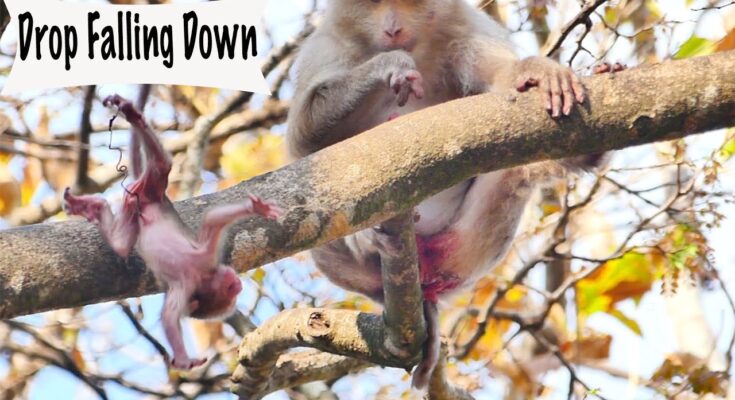
Is a monkey the right pet for you? Explore the challenges and joys of living with these intelligent creatures
In a truly heart-wrenching scene captured in the wild, a newborn mom experienced the unimaginable just moments after giving birth. Exhausted and vulnerable, the mother, likely a primate, was forced out of a tree from a considerable height, leaving onlookers in shock and disbelief.
The Miracle of Birth in the Wild
Nature can be both beautiful and unforgiving. Giving birth in the wild is an arduous task, and mothers often endure extreme physical and emotional stress. For this mom, the ordeal didn’t end with the arrival of her baby; instead, her struggle took a tragic turn.
A Brutal Twist of Events
Moments after delivering her newborn, the mother faced an unexpected challenge. Whether due to territorial disputes, dominance, or social hierarchy within her group, she was pushed or forced out of the tree. This act of aggression highlights the harsh realities of survival in the wild.
A Testament to Strength and Resilience
Despite the incident, mother animals are known for their resilience and unwavering dedication to their offspring. It’s a poignant reminder of the incredible sacrifices made by mothers, human or animal, to ensure the well-being of their young.
How Can We Help?
Scenes like these bring to light the importance of conservation and the need to protect wildlife and their habitats. Understanding animal behavior and ensuring their safety can lead to better coexistence between humans and nature.
This heartbreaking incident is a reminder of the raw beauty and harshness of the natural world. Let us work together to appreciate and protect the incredible creatures that share our planet.
Tragic Story: Newborn Monkey’s Heartbreaking Journey from Birth to Death After Being Abandoned by Its Mother 😢
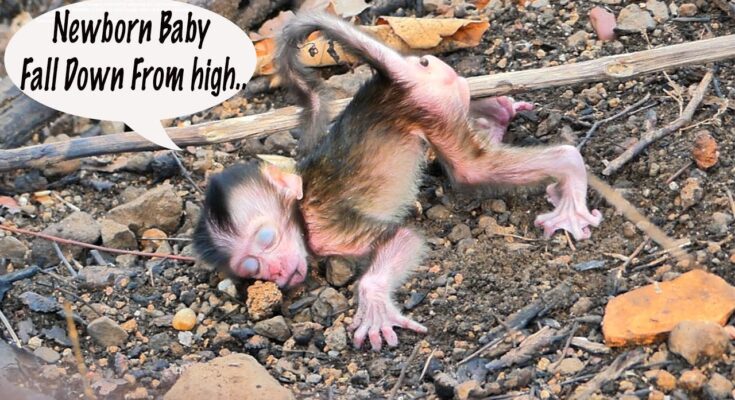
The Amazing Talents of Monkeys and Baby Monkeys
Monkeys are fascinating creatures, often admired for their intelligence, agility, and emotional depth. These qualities make them stand out in the animal kingdom. In this article, we’ll uncover the special talents of monkeys and their adorable offspring, baby monkeys, showcasing why they continue to captivate us.
Monkeys: Masters of Intelligence and Adaptability
- Problem-Solving Abilities
Monkeys are exceptionally clever, often solving puzzles and overcoming challenges in their environment. For instance, many species use tools like sticks to extract termites from mounds or crack open nuts, demonstrating an advanced understanding of their surroundings. - Social Skills
Monkeys thrive in communities, creating intricate social hierarchies. They use a variety of gestures, facial expressions, and vocalizations to communicate, build bonds, and maintain order within their groups. - Agility and Physical Prowess
Known for their athletic abilities, monkeys effortlessly swing through trees, leap across distances, and navigate complex terrains. This skill not only helps them evade predators but also aids in finding food in hard-to-reach places.
Baby Monkeys: Born to Learn and Adapt
Baby monkeys are equally remarkable, showing unique talents from a young age.
- Rapid Learning
From birth, baby monkeys learn by observing their mothers and other members of their troop. This includes mimicking behaviors like foraging, grooming, and climbing, which are essential for their survival. - Playful Curiosity
Play is an important part of a baby monkey’s development. Through playful interactions, they develop motor skills, strengthen bonds with their peers, and learn the social rules of their group. - Emotional Expressions
Baby monkeys display emotions such as joy, fear, and curiosity through their facial expressions and body language, drawing parallels to human infants. This emotional depth makes them endearing and relatable.
Fun Fact: Monkeys and Art!
Did you know some monkeys have been trained to create simple paintings? Their creativity has been a source of wonder and entertainment for humans worldwide, further showcasing their intelligence.
Monkeys and baby monkeys remind us of the beauty of nature’s diversity. Their incredible talents, from problem-solving to emotional expression, inspire us to appreciate the wonders of wildlife.
